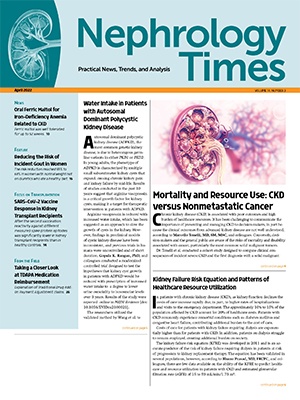
Gout is a metabolic condition that causes the most common form of inflammatory arthritis, associated with painful recurrent flares and joint damage. Historically, gout has been considered a disease of affluent, middle-aged men; however, over past decades the prevalence of gout has seen a substantial increase. Recent analyses of the Global Burden of Disease Study revealed a disproportionate increase in gout burden among women between 1990 and 2017. That study results highlighted the need for dietary management and other preventive strategies to mitigate the increases.
Female gout is associated with key comorbidities more frequently than male gout, including coronary artery disease, hypertension, type 2 diabetes, and chronic kidney disease. According to Chio Yokose, MD, and colleagues, despite perceived differences from males in gout risk factors and disproportionate worsening in disease and comorbidity burden globally, there are few female-specific gout data available.
The 2020 to 2025 Dietary Guidelines for Americans recommend multiple healthy eating patterns for the prevention of cardiovascular-metabolic outcomes; the guidelines may also be relevant to the prevention of female gout. Dr. Yokose et al. conducted a prospective cohort study to examine the associations of dietary scores for the latest guideline-based healthy eating patterns with the risk of incident female gout. Results were reported online in JAMA Internal Medicine [doi:10.1001/jamainternmed.2021.7419].
The study exposures were four healthy patterns that reflect the 2020 to 2025 Dietary Guidelines for Americans: (1) Dietary Approaches to Stop Hypertension (DASH); (2) Alternative Mediterranean Diet Score; (3) Alternative Healthy Eating Index (AHEI); and (4) Prudent. The researchers compared adherence to the four healthy patterns with the Western diet (unhealthy). Scores were derived from validated food frequency questionnaires. The primary outcome of interest was incident, physician-diagnosed female-specific gout.
The study included 80,039 women in the United States in the Nurses’ Health Study who were followed via questionnaires every 2 years beginning in 1984. Eligible participants in the current study had no history of gout at baseline; questionnaire responses through 2018 were used for the analysis.
Statistical analyses were preformed from September 2020 to August 2021. The researchers used Cox proportional hazards modeling to estimate the risk for incident gout. Dietary pattern scores were divided into quintiles, with the highest quintile indicating greatest adherence to a given pattern.
During 34 years of follow-up, there were 3890 documented cases of incident gout among the 80,039 women. Mean age at baseline was 50.5, and mean body mass index was 25.0 m/kg2. For each of the four healthy diets, women in the highest quintile tended to be older than those in the lowest quintile; for the Western diet, the reverse was seen. Women in the highest quintile of DASH and AHEI scores tended to have lower intakes of alcohol and coffee compared with the lowest quintile. Among the controls (Western diet), there was little difference in alcohol and coffee intake across quintiles.
Women in the highest quintile of the Western score has the highest total energy intake, followed by women in the highest quintiles of the Prudent and Mediterranean dietary scores. Spearman correlation coefficients between the four health diet scores ranged from 0.478 to 0.68 (all P<.001). With the exception of use of hormone replacement therapy (HRT), the nondietary variables were well-balanced between quintiles within each dietary pattern; HRT tended to be higher in quintile 5 of the healthy diets and quintile 1 of the Western diet.
There were consistent associations between lower risk of incident gout and the four healthy dietary patterns. The risk of reduction was greatest with the DASH dietary pattern, with a 32% reduced risk of incident gout in the most adherent quintile compared with the least adherent (multivariable hazard ratio [HR], 0.68; 95% confidence interval [CI], 0.61-0.76; P for trend <.001). For the three other healthy dietary patterns, the corresponding risk reduction for the highest versus the lowest quintile of adherence ranged from 12% to 25%.
There was an association between the highest quintile score of the Western diet (the most unhealthy) and 49% increased risk in incident gout compared with those with the lowest quintile (healthiest) (HR, 1.49; 95% CI, 1.3301.68; P for trend <.001).
Subgroup Analyses
At the time of gout diagnosis, 43% of the women in the cohort (n=1659) were using diuretics, 41% (n=1593) were obese, and 52% (n=2210) used alcohol. When the participants were stratified by those variables, the associations of each diet with the risk of incident gout persisted, with the exception of the Mediterranean diet among overweight or obese women, with seemed to have minimal or no effect on gout risk. Results were similar in additional subgroup analyses according to menopausal status and HRT use.
In the joint analysis, the women with normal body mass index who were most DASH adherent had a 68% lower risk of gout (HR, 0.32; 95% CI, 0.26-0.38) compared with the least adherent women who were obese or overweight. When DASH diet adherence was combined with no diuretic use, the corresponding risk reduction was 65% (HR, 0.35; 95% CI, 0.30-0.40); however, the joint effects between DASH diet and alcohol use were less notable. Trends were similar with the Mediterranean, AHEI, and Prudent dietary patterns. The joint associations of those factors and the Western diet were notable in the opposite direction, with a nearly 3.5-fold higher risk of gout among overweight or obese women most adherent to Western diet, and a 3-fold higher risk among the women using diuretics.
The researchers cited the observational design of the study as a possible limitation to the findings; the design created the possibility that the findings were subject to unmeasured or residual confounding. In addition, the absolute rates of gout and the distribution of dietary intake may not be representative of a random sample of American women.
In conclusion, the authors said, “These large-scale, long-term prospective cohort findings extend the pleotropic benefits of the 2020 to 2025 Dietary Guidelines for Americans to female gout prevention, offering multiple healthy eating patterns that can be adapted to individual food traditions and preferences to reduce women’s underrecognized risk of developing gout while simultaneously addressing cardiovascular comorbidities.”
Takeaway Points
- Researchers conducted a prospective cohort study to examine associations of dietary scores for guidelines-based healthy eating patterns with the risk of incident female gout.
- Participants from the Nurses’ Health Study with highest adherence to one of four healthy eating patterns had lower risk of incident gout compared with those who ate an unhealthy diet.
- The risk reduction reached 65% to 68% in women who ate a healthy diet and had normal weight and did not use diuretics.







 © 2025 Mashup Media, LLC, a Formedics Property. All Rights Reserved.
© 2025 Mashup Media, LLC, a Formedics Property. All Rights Reserved.